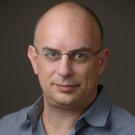I completed undergraduate studies in physics and doctoral studies in computational neuroscience at the Hebrew University in Jerusalem. After my PhD I became a high-school teacher for several years and taught physics as well as courses in the philosophy of science, ethics in science and neural computation. I also established a research laboratory at the school, where I supervised many research projects in brain sciences and in robotics. After postdoctoral studies at the National Institute of Mental Health in the US I joined the Department of Cognitive and Brain Sciences at Ben-Gurion University.
Research in my lab combines experimental work, data analysis and computational modeling aimed at developing new insights into psychiatric and neurological phenomena. On the experimental side, we record brain activity using EEG from healthy subjects and from various patient populations. Using mathematical analyses and machine learning techniques we develop neuromarkers to quantify the underlying neural dynamics and help in the diagnosis of patients. Our major focus is on epilepsy and on schizophrenia, but we study other related phenomena. Another line of experimental research in the lab focuses on brain computer interfaces and neurofeedback. We develop new approaches to decode neural activity in real-time and novel neurofeedback treatments.
On the theoretical side, the lab develops and studies computational models of neuronal networks to gain insights into how changes in neural dynamics lead to brain disorders and how neural plasticity may assist in restoring healthy neural dynamics. In particular, we use information theoretic tools to study the evolution of recurrent networks that optimize the representation of information. For example, using this framework, we developed models for tinnitus and for synaesthesia. A major focus of the lab is on the theory of critical brain dynamics, which hypothesizes that the brain operates near a phase-transition, in a manner similar to physical systems near a phase-transition.
The group is highly interdisciplinary, and includes students with computational background, who come from various disciplines such as cognitive sciences, computer science, biomedical engineering, physics and more.
Here is a short (~2 min) animation about our research on neuronal avalanches and its potential application in the context of epilepsy:
Here is a talk I gave at the Hebrew University in 2012 about "Neuronal avalanches in the resting MEG of the human brain" (1 hour video):


